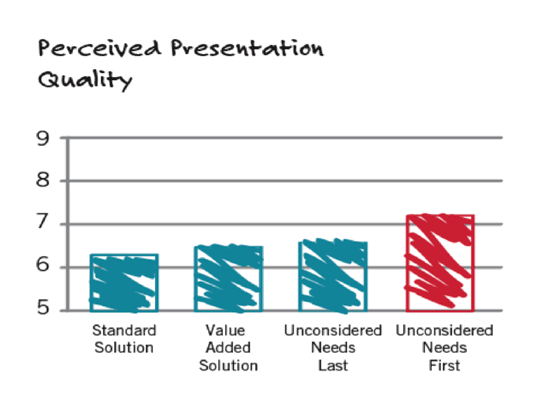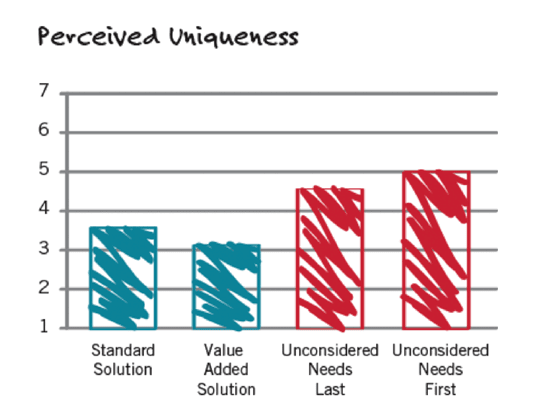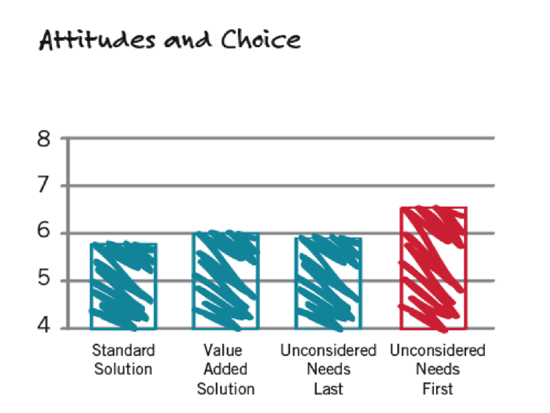Have you thought about this?
6th July 2015 | Tim Riesterer and Professor Zakary Tormala
Tim Riesterer, chief strategy officer at Corporate Visions, explains why articulating a customer’s “unconsidered needs” can make you stand out.

The proposition
Does the following scenario sound familiar? It’s your first sales conversation with a prospect in the field. There you are, face-to-face with a potential buyer, launching into your pitch.
So far, so good. Why wouldn’t it be? You know what your prospect’s needs are – she’s stated them in no uncertain terms – and you also know your solution portfolio is fully equipped to tackle each one head-on. Brimming with confidence, you respond to your prospect’s stated challenges with your range of first-rate capabilities. Tack on some value-added services at the end for good measure, and it’s game, set and match. Right?
Well, not exactly. In fact, you have just put yourself into a commoditised conversation.
In a vacuum, the approach sketched above might not seem so bad. But it loses a whole lot of lustre when you consider that many of your competitors will take a similar tack in their sales interactions, responding to the prospect’s stated needs with similar capabilities. Far from differentiating you, this type of sales conversation may actually be putting you at parity with the competition and reinforcing the buyer’s perception that you offer a commodity, indistinguishable from the other qualified competitors in your market.
So-called ‘best practice’ like voice of the customer-based messaging may not be a best practice at all
That’s where the discussion shifts to two selling challenges. First, the sales cycle expands, the customer feels a lack of urgency to change and you get stalled, no-decision deals. Secondly, if the deal does survive, the discussion turns to price instead of value, torpedoing whatever claim to uniqueness you might’ve had and causing your margins to wither. In the commodity conversation, it becomes increasingly difficult to create the uniqueness and urgency you need to convince prospects to do something different with you.
So, the question that needs to be asked is this: How do you avoid this race to the bottom, where you look and sound like everyone else?
Urgency, uniqueness and unconsidered needs
As you learn more about what actually compels prospects to take action – and the roles that urgency and uniqueness play in that equation – it becomes clear that an alternative sales messaging approach is needed: one that galvanises prospects into doing something different, while distinguishing you from the pack.
The approach I’m proposing is what I call messaging to your prospects’ “unconsidered needs”. When it comes to identifying needs in this category, “voice of the customer” messaging will not help you. That’s because these are the potential problems your prospect doesn’t yet know about – the challenges, issues and trends they’ve either overlooked, underestimated or simply aren’t aware of.
In theory, a messaging approach centred on unconsidered needs would seem to hold a lot of promise. But, practically speaking, does it actually have a measurable effect on buyers’ perception of your value? Does it actually help your reps create differentiation, allowing them to be more compelling and persuasive at convincing prospects to make the leap and leave the status quo?
These questions were the catalyst for an experiment I conducted recently with Dr Zakary Tormala, a professor at the Stanford University Graduate School of Business, and an expert in persuasion. What we discovered validated our suspicion that so-called “best practice” like voice of the customer-based messaging may not be a best practice at all.
The research
Methodology: one scenario, four conditions
We began by recruiting 400 individuals (average age 33) and asking them to participate in an online experiment.
We developed a specific scenario for the study, asking our participants to imagine themselves as owners of a large company that was exploring potential growth opportunities in the face of a possible recession. To cope with cash-flow challenges linked to slow sales, sluggish customer payments and higher costs, the company was seeking a $10 million line of credit from a financial lending firm. Participants were then told they would view a pitch from a particular lender who’d like to partner with them.
What participants did not know, however, was that they were being randomly assigned to one of four experimental conditions, each roughly two minutes in length. With each condition, the core services were identical; what varied were certain crucial aspects of the message and structure of the pitch.
The conditions (or pitches) were as follows:
- Standard Solution – In this pitch, participants received a straightforward pitch in which the lender reviewed the stated customer needs and offered a $10 million credit line at a “competitive rate” and then presented credentials, noting that his bank had 75 years of experience in the community and was committed to providing local companies with the help they need. In other words, the approach mimicked typical corporate sales presentations.
- Value Added – Here the pitch was identical to the previous one, but then the lender introduced additional capabilities, noting: (a) his bank had on-staff experts who had a great deal of experience and could provide useful business advice in difficult economic times; and (b) it had a wide range of services that could be tailored to an individual company’s needs. This approach is similar to presentations that include “value-added services” to create perceived differentiation.
- Unconsidered Needs-Last – In this condition, the beginning of the pitch was the same as in the Value Added condition. That is, the lender offered a $10 million loan at a “competitive rate” and noted that his bank had 75 years of experience in the community and was committed to providing local companies with the help they need. Following this information, the lender introduced an unconsidered need with an accompanying solution.
Specifically, he explained (“You should also know, however, that industry data suggests…”) that 42% of companies that take a cash infusion during challenging economic times end up failing due to underlying problems in their process, operations, sales, or marketing. Thus, he went on, the bank had on-staff experts who could work with companies to make sure there are no hidden problems in these areas and to help ensure that the cash infusion would have maximum positive impact. In essence, this pitch provided the same core offerings as the value added pitch, but it highlighted a potential problem area before mentioning the on-staff experts and diverse range of services.
- Unconsidered Needs-First – This pitch was virtually identical to the Unconsidered Needs-Last condition, but the order was reversed. In this case, the lender began by highlighting an unconsidered need (“Before we get started, though, I’d like to share this statistic with you…”).
Again, he explained that 42% of companies that take a cash infusion during challenging economic times end up failing due to underlying problems in their process, operations, sales, or marketing. And he noted the bank had on-staff experts who work with companies to make sure there are no hidden problems in these areas and to help make sure that the cash infusion would have maximum positive impact. Following this information, the lender offered a $10 million loan at a “competitive rate” and noted that his bank had 75 years of experience in the community and was committed to providing local companies with the help they need. Thus, the content in the two unconsidered needs conditions was identical, but the sequence or order of that content was manipulated.
Results: a statistically significant winner
We then asked participants to answer a sequence of questions to help us measure the impact of the presentations – in particular, their quality, uniqueness and effect on participants’ attitudes and choices.
Although all participants received the same core offer, the Unconsidered Needs-First presentation outperformed the others on a variety of metrics assessing message impact. In terms of uniqueness and presentation quality, the Unconsidered Needs-First condition was rated as more compelling, more thorough and generally better than the other three messages. The specific questions from which we gleaned the presentation quality results were as follows:
- How compelling was the presentation (eg, how convincing was it to you personally?
- How thorough did the pitch seem to be?
- Overall, was it a good or bad pitch?
To determine presentation uniqueness – or the extent to which participants viewed their pitch as unique and unexpected – we asked them to assess how unusual or unexpected the content of the pitch was. We also asked them how different or unique the pitch seemed to be.
As you can see from the diagrams below, the Standard Solution and Value Added pitches differed negligibly on the quality and uniqueness metrics.

Figure 1: Presentation quality ratings. Perceived quality was greater in the unconsidered needs-first condition (by 11.41%) than the other three, which did not differ from each other. (Scales ranged from one to nine with higher ratings indicating greater quality.)

Figure 2: Presentation uniqueness ratings. Perceived uniqueness was higher in both unconsidered needs presentations (by more than 41 per cent) relative to the others, with the value-added condition falling to last place. (Scales ranged from one to nine with higher ratings indicating more unique and unexpected.)
Participants then completed a variety of questions designed to assess something we deemed even more vital for selling purposes: the persuasive impact of the presentations they viewed – in other words, the extent to which the message enhanced their attitudes toward the lending firm and boosted their likelihood of choosing it. The items were:
- How likely would you be to choose this lending company as your lending partner?
- How likely is it that you would accept the pitch and go with this lender’s offer?
- Overall, how would you rate this company as a potential lender?
- How would you describe your attitude toward this lending firm?
- How likely is it that you would choose this lending firm over other, competing firms offering a similar rate?
- How likely would you be to choose this lending firm over other firms offering a slightly lower rate?
- How much more than the proposed interest rate would you be willing to pay to partner with this lending firm?
Across all these choice and attitude dimensions, the unconsidered needs-first condition outperformed the other three, which had no statistically significant difference from each other.
Conclusion: unconsidered needs first are more persuasive

Figure 3: Attitudes and choice. Attitudes and choice likelihood ratings were more favourable in the unconsidered needs first condition (by nearly 10.3%) than in the other three, none of which differed from each other. (Scales ranged from one to nine with higher ratings indicating more favourable attitudes and more likely to choose.)
By examining the choice and attitude measures in conjunction with the uniqueness and quality findings, you can make a very powerful argument from the data, which is: only when unconsidered needs come first do they enhance the persuasive impact of a pitch.
While both pitches that incorporated unconsidered needs were perceived as unique and unexpected, only when that need was introduced at the outset of the pitch did it actually enhance perceptions of quality and persuasive power.
According to Tormala, this is compatible with uncertainty principles, which hold that injecting unexpected information into a conversation can create uncertainty; this in turn boosts message processing.
This study strongly suggests that you can capitalise on that effect by introducing unconsidered needs into your customer conversations, but only if you do it early. If you wait until the end of the conversation to include that information, it’s too late to promote increased processing of incoming information and you won’t maximise your persuasive power.
Case-study 1 – financial services
Corporate Visions helped a financial company develop a “distinct point of view” based on a message that led with an unconsidered need. The company’s top sales performer, decided to test it out on a large prospect that had politely turned him down each of the past ten years.
On the 11th time, armed with the new message, his fortunes took a turn: in addition to convincing the client to meet with him a second time, he was able to move hundreds of millions in assets in what became the company’s biggest deal of the year. The formerly sceptical salesperson credited the new message with creating the opportunity, because the approach was the only thing he had changed from previous attempts with the same client.
Case-study 2 – technology
An IT products reseller used the “unconsidered needs” pitch approach to launch a new emphasis on services as differentiator from the competition. This helped its salespeople make the transition from product-centric presentations to customer-centric conversations and helped them gain access to the C-suite at some major global corporations, meeting with titles and prospects they had seldom ever spoken to in the past.
A webcast presentation based on the same pitch has become the number one “most viewed” exhibitor presentation on analyst firm Gartner’s website. They are also using the pitch to screen new sales hires, who must review the materials and deliver the story in a role-play scenario before they are hired.




